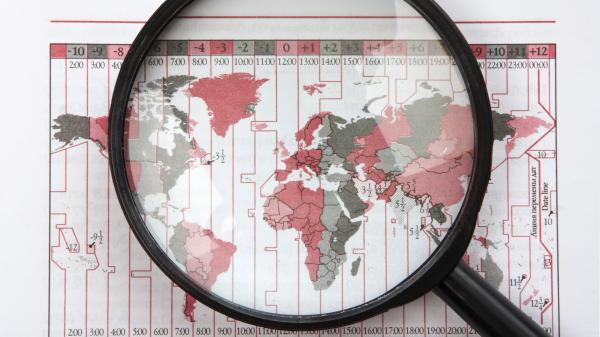Why Do We Have Time Zones?
The expansion of transport and communication during the 19th century created a need for a unified time-keeping system, and time zones were introduced.

The expansion of transport and communication during the 19th century created a need for a unified time-keeping system.
©thinkstockphoto.com
Before clocks were invented, people kept time using different instruments to observe the Sun’s meridian passing at noon. The earliest time measuring devices we know of are sundials and water clocks.
A five-minute history of timekeeping
Chronometers Changed the Game
The pendulum clock was developed during the 17th century. However, these clocks were not sufficiently accurate to be used at sea to determine longitude and for scientific time measurement in the 18th century.
In 1764, the chronometer was invented. Chronometers measured time accurately in spite of motion or varying conditions, and became popular instruments among many merchant mariners during the 19th century.
Clocks Based on the Sun
Even after the chronometer many towns and cities set clocks based on sunsets and sunrises. Dawn and dusk occur at different times, but time differences between distant locations were barely noticeable before the 19th century because of long travel times and the lack of long-distance communications.
The use of local solar time became increasingly awkward as railways and telecommunications improved. Time zones were, therefore, a compromise, relaxing the complex geographic dependence while still allowing local time to be approximate with mean solar time.
19th Century Challenges
American railroads maintained many different time zones during the late 1800s. Each train station set its own clock making it difficult to coordinate train schedules and confusing passengers. Time calculation became a serious problem for people traveling by train (sometimes hundreds of miles in a day), according to the Library of Congress. Every city in the United States used a different time standard, so there were more than 300 local sun-times to choose from. Railroad managers tried to address the problem by establishing 100 railroad time zones, but this was only a partial solution to the problem.
Operators of the new railroad lines needed a new time plan that would offer a uniform train schedule for departures and arrivals. Four standard time zones for the continental United States were introduced on November 18, 1883.
One Prime Meridian
Britain, which already adopted its own standard time system for England, Scotland, and Wales, helped gather international consensus for global time zones in 1884.
Various meridians were used for longitudinal references among different countries before the late 1800s, and the Greenwich Meridian was the most popular of these. The Greenwich Observatory's reputation for the reliability and accuracy in publications of its navigational data was one factor that contributed to the Greenwich Meridian’s popularity. Moreover, the shipping industry would benefit from having just one prime meridian. Many people informally recognized the Greenwich Meridian as the prime meridian before the International Meridian Conference in 1884.
Sir Sandford Fleming was one of the key players in developing a satisfactory worldwide system of keeping time. He advocated the adoption of a standard or mean time and hourly variations from that following established time zones. He also helped convene the International Meridian Conference in 1884, where the international standard time system was adopted.
The International Meridian Conference
The International Meridian Conference in Washington DC, USA, adopted a proposal in October 1884. The proposal stated that the prime meridian for longitude and timekeeping should be one that passes through the center of the transit instrument at the Greenwich Observatory in the United Kingdom (UK). The conference established the Greenwich Meridian as the prime meridian and Greenwich Mean Time (GMT) as the world’s time standard. The international 24-hour time-zone system grew from this, in which all zones referred back to GMT on the prime meridian.
The main factors that favored Greenwich as the site of the prime meridian were:
- Britain had more shipping and ships using the Greenwich Meridian than the rest of the world put together (at the time). The British Nautical Almanac started these charts in 1767.
- The Greenwich Observatory produced data of the highest quality for a long time.
Is the prime meridian in the wrong place?
Time Zones in the 20th Century
Interestingly, many French maps showed zero degrees in Paris for many years despite the International Meridian Conference’s outcomes in 1884. GMT was the universal reference standard – all other times being stated as so many hours ahead or behind it – but the French continued to treat Paris as the prime meridian until 1911. Even so, the French defined their civil time as Paris Mean Time minus 9 minutes and 21 seconds. In other words, this was the same time as GMT.
In 1972, Coordinated Universal Time (UTC) replaced GMT as the world's time standard. France did not formally use UTC as a reference to its standard time zone (UTC+1) until August in 1978.
Standard time, in terms of time zones, was not established in United States law until the Act of March 19, 1918. The act also established daylight saving time in the nation. Daylight saving time was repealed in 1919, but standard time in time zones remained in law, with the Interstate Commerce Commission (ICC) having the authority over time zone boundaries.
Many countries started using hourly time zones by the late 1920s. Many nations today use standard time zones, but some places use 30 or 45 minute deviations from standard time. Some countries such as China use a single time zone even though their territory extends beyond the 15 degrees of longitude.